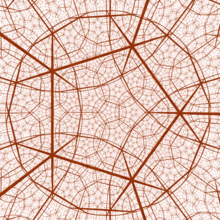
Four dodecahedra meet at each edge, and eight meet at each vertex, like the cubes of a cubic tessellation in E3
In mathematics, hyperbolic space of dimension n is the unique simply connected, n-dimensional Riemannian manifold of constant sectional curvature equal to −1.[1] It is homogeneous, and satisfies the stronger property of being a symmetric space. There are many ways to construct it as an open subset of with an explicitly written Riemannian metric; such constructions are referred to as models. Hyperbolic 2-space, H2, which was the first instance studied, is also called the hyperbolic plane.
It is also sometimes referred to as Lobachevsky space or Bolyai–Lobachevsky space after the names of the author who first published on the topic of hyperbolic geometry. Sometimes the qualificative "real" is added to distinguish it from complex hyperbolic spaces.
Hyperbolic space serves as the prototype of a Gromov hyperbolic space, which is a far-reaching notion including differential-geometric as well as more combinatorial spaces via a synthetic approach to negative curvature. Another generalisation is the notion of a CAT(−1) space.
- ^ Grigor'yan, Alexander; Noguchi, Masakazu (1998), "The heat kernel on hyperbolic space", The Bulletin of the London Mathematical Society, 30 (6): 643–650, doi:10.1112/S0024609398004780, MR 1642767
